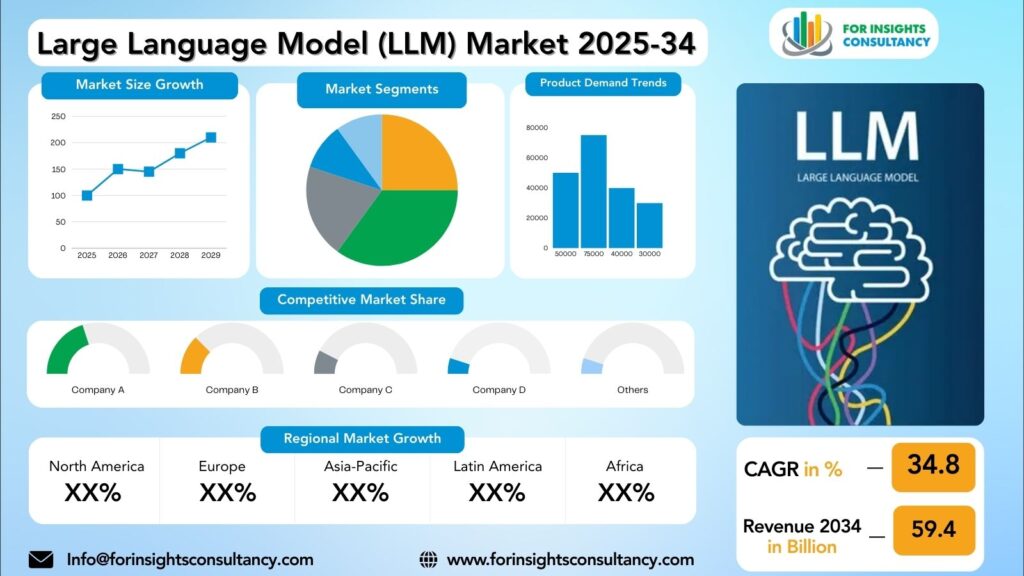
Large Language Model (LLM) Market Research Report by Model Type (General-Purpose LLMs, Domain-Specific or Specialized LLMs), by Application (Chatbots and Virtual Assistants, Content Generation, Code Generation and Software Development, Natural Language Processing (NLP), Customer Service and Support), by Deployment Mode (Cloud-based, On-premises, Hybrid), And Region Global Market Analysis and Forecast, 2025-2034
Aug-2025 Formats | PDF | Category: IT | Delivery: 24 to 72 Hours
Large
Language Model (LLM) Market is forecast to increase from USD 12.8 billion in
2025 to USD 59.4 billion by 2034, at a CAGR of 34.8%.
Large Language Model (LLM) Market: A Comprehensive Overview and Future Developments
The Large
Language Model (LLM) market is currently experiencing substantial growth and
innovation, driven primarily by the rising demand for natural language
understanding across various applications, including chatbots, virtual
assistants, and language translation services. Significant advancements in artificial
intelligence and machine learning technologies are making LLMs increasingly
sophisticated in their ability to comprehend and generate human-like text.
Looking
ahead, the development trajectory of the LLM market appears promising, with
ongoing efforts aimed at enhancing the accuracy, efficiency, and scalability of
these models. As the necessity for more context-aware and personalized
responses intensifies, LLMs are anticipated to evolve, facilitating more
nuanced and human-like interactions. Furthermore, the incorporation of
multi-modal capabilities—merging text with images and speech—is expected to
broaden the applicability of LLMs, enhancing their functionality across
different domains.
In
summary, the future of the Large Language Model market is optimistic,
characterized by continuous research and development, which is poised to yield
more intelligent and versatile language models that could transform the ways in
which we engage with technology.
Large Language Model (LLM) Market Dynamics
Growth Drivers
The
growth of the Language Learning (LLM) market is primarily driven by
advancements in artificial intelligence technologies. As AI algorithms become
more sophisticated, businesses are leveraging these technologies to gain
insights from unstructured data, automate repetitive tasks, and improve
customer interactions. The globalization of businesses and the rise of the
digital economy have led to a growing demand for multilingual capabilities in
language processing systems. LLMs can understand and generate content in
multiple languages, making them valuable for companies operating in diverse
regions. Natural Language Understanding (NLU) is a key component of LLMs,
enabling machines to comprehend human language in a meaningful way. With the
increasing complexity of human communication, there is a growing demand for
LLMs that can accurately interpret context, sentiment, and intent, delivering
personalized and relevant content to users. The ease of integration of LLMs
into existing systems, such as APIs and SDKs, is also contributing to the
market’s growth.
Restraints
Large-scale
learning models (LLMs) use large amounts of text data, raising concerns about
data privacy and security. Companies must comply with regulatory requirements
and protect sensitive information. LLMs can perpetuate biases in training data,
requiring ethical considerations to maintain trust. Training and fine-tuning
LLMs require significant computational resources and can be costly,
necessitating investments in infrastructure and resources to support their
development and deployment effectively.
Opportunity
LLMs can
enhance customer experience by providing personalized communication and
real-time response to queries, improving customer satisfaction and loyalty.
They can process vast amounts of unstructured text data, enabling businesses to
extract valuable insights and trends. LLMs can also streamline operations by
automating repetitive tasks like document analysis and content creation,
leading to cost savings and increased productivity. Additionally, LLM
technology can be used to develop innovative products and services, such as
voice assistants and smart chatbots, by creating advanced language-based
applications. This allows businesses to stay ahead of the curve and improve
their overall customer experience.
Challenges
The
Language Learning Models (LLM) market faces several challenges, including data
privacy concerns, bias and fairness issues, scalability and performance, and
ethical use. As these models become more advanced, concerns arise about responsible
data usage and handling. Bias can impact the results produced by these models,
making it crucial for businesses to address these issues. Scalability and
performance are also essential for businesses to maintain high performance
levels, requiring investment in infrastructure and technology. Ethical
considerations are also crucial, as LLMs can be used in various applications,
from content generation to automated customer interactions, requiring
responsible and ethical use.
Large Language Model (LLM) Market
Top Companies Covered In This Report:
Evaluate
The Strategic Positioning And Innovation Pipelines Of Leading Market
Companies-From Multinational Enterprises To Disruptive Regional Firms.
Understand How Key Players Are Innovating, Expanding, And Capturing Value, And
Use Competitive Benchmarks To Plan Your Next Move.
Large Language Model (LLM) Market News
August 7,
2025 GPT-5 is here: OpenAI promises better writing, faster research
OpenAI
calls GPT-5 its most advanced AI model, with upgrades in accuracy, speed, tone
control, and complex task handling. OpenAI today introduced GPT-5, its most
advanced large language model. OpenAI promised faster answers, greater
accuracy, and better performance in everything from content creation to coding.
Mar 10,
2025 How to set up a large language model (Google Gemma) while keeping control
of your data.
April 20,
2023 Stability AI launches StableLM, an open-sourced large language model
Stability
AI, the company that brought us the popular text-to-image generator Stable
Diffusion recently launched a new open-sourced large language model called
StableLM, which is available on GitHub.
Segmented View of the Industry:
The Large
Language Model (LLM) Market Is Mapped Through A Multidimensional Lens-Tracking
Shifts Across Product Type, Applications, And Geographic Regions. This
Segmented Approach Enables Businesses To Localize Their Growth Plans And Align
Offerings With The Most Profitable Demand Centers.
Segmentation
by Model Type
- General-Purpose
LLMs
- Domain-Specific
or Specialized LLMs
Segmentation
by Application
- Chatbots
and Virtual Assistants
- Content
Generation
- Code
Generation and Software Development
- Natural
Language Processing (NLP)
- Customer
Service and Support
Segmentation
by Deployment Mode
- Cloud-based
- On-premises
- Hybrid
Segmentation
by End-User Industry
- IT
& IT-Enabled Services (ITeS)
- Retail
and E-commerce
- Healthcare
and Life Sciences
- Banking,
Financial Services, and Insurance (BFSI)
- Media
and Entertainment
Global Geographic Coverage:
The
Report Provides In-Depth Qualitative and Quantitative Data On The Large
Language Model (LLM) Market For All Of The Regions And Countries Listed Below:
North America
The
Large Language Model (LLM) market in North America is set for substantial
growth in upcoming years, largely fueled by the fast-evolving digital economy.
This anticipated expansion is supported by a projected GDP growth of 5%
alongside a low inflation rate of 2%. In the United States, a government
subsidy specifically designed to encourage the adoption of AI technology serves
as a major catalyst for LLM products, thus creating a conducive climate for
market development. Online retail remains the leading channel for distributing
LLM products, while social media platforms are identified as the
fastest-growing avenue for market penetration. North American consumers exhibit
a strong preference for sustainability, ethical sourcing, and localism when
making purchase decisions related to LLM products. Conversely, in many emerging
markets, consumer preferences lean more heavily towards price and status, which
may diminish the importance of these ethical considerations.
Europe
The
Large Language Model (LLM) market in Europe is poised for substantial growth,
bolstered by a strong Gross Domestic Product (GDP) and a low inflation rate
across the region. A notable driver of this growth is the governmental subsidy
in Germany aimed at fostering AI research and development, which encourages the
adoption of LLM technologies. The primary distribution channel for LLM products
in Europe is online platforms, whereas the most rapidly expanding channel
involves collaborations with educational institutions and language learning
centers.
Furthermore,
European consumers are increasingly prioritizing values such as sustainability,
ethical sourcing, and localism when selecting LLM products, highlighting the
necessity for these elements to be integrated within market offerings. In
emerging markets, where factors like price and status are paramount, companies
will face the challenge of balancing affordability with high quality and
ethical standards to remain competitive and attractive to a diverse consumer
base.
Asia Pacific
The
Large Language Model (LLM) market in the Asia Pacific region is set for
substantial growth, primarily fueled by increasing GDP and a low inflation
rate. A significant factor driving this market is the trend of social media
influencers who actively promote language learning applications, especially in
countries such as Japan and South Korea. Online platforms serve as the
predominant channel for distributing LLM products, while the mobile app stores
are identified as the fastest-growing channel, attributed to the rising
smartphone penetration in emerging markets. Additionally, consumers in these
regions generally prioritize affordability and social status over
sustainability, ethical sourcing concerns, or localism. In contrast, developed
markets, including Australia and New Zealand, are witnessing a growing interest
in ethical sourcing practices.
Middle East and Africa
The
Large Language Model (LLM) market in the Middle East and Africa is witnessing
significant growth, driven by the projected GDP growth of 3.5% and inflation
rate of 2.8% in the region. In the UAE, a specific government subsidy aimed at
promoting digital innovation has fueled the adoption of LLM technologies,
making it a key non-replicable driver in the country. The dominant channel for
LLM products in this region is online platforms due to the increasing internet
penetration. However, the fastest-growing channel is through partnerships with
educational institutions for language learning purposes. Consumers in this
region prioritize sustainability and ethical sourcing, making it a must-have
for businesses operating in the LLM market. In many emerging markets in the
region, price and status still dominate consumer preferences, highlighting the
need for competitive pricing strategies.
Reasons to Buy:
- The
Research Would Help Top Administration/Policymakers/Professionals/Product
Advancements/Sales Managers And Stakeholders In This Market In The
Following Ways.
- The
Report Provides Large Language Model (LLM) Market Revenues At The
Worldwide, Regional, And Country Levels With A Complete Analysis To 2034
Permitting Companies To Analyze Their Market Share And Analyze
Projections, And Find New Markets To Aim For.
- To Understand
The Most Affecting Driving And Restraining Forces In The Market And Their
Impact On The Global Market.
- Major
Changes And Assessment In Market Dynamics And Developments.
- The
Objective Of The Large Language Model (LLM) Market Report Is To Identify New
Business Opportunities Using Quantitative Market Forecasts.
- Formulate
Sales And Marketing Strategies By Gaining An Understanding Of Competitors,
Their Positioning, And Strengths & Weaknesses.
Faq – What Global Leaders Are Asking
What Is
The Growth Prospect For The Large Language Model (LLM) Market By 2034?
Large
Language Model (LLM) Market Is Expected To Achieve A Stable Growth Rate With A
Compound Annual Growth Rate (Cagr) Of About 34.8% From 2025 Through 2034.
What Is
Driving The Growth Of The Large Language Model (LLM) Market?
The
growth of the LLM market is primarily driven by the increasing demand for
advanced natural language processing and AI-powered automation across various
industries. Additionally, significant investments from tech giants and startups
in research and development are accelerating advancements in model capabilities
and accessibility.
Who Are
The Key Players In The Large Language Model (LLM) Market, And What Are Their
Market Shares?
The Large
Language Model (LLM) Market Includes Major Companies Like OpenAI, Anthropic,
Meta, Microsoft, Hugging Face, Stability AI, LightOn, Cohere, Google, Turing,
Stability AI.
Specific
Market Share Data Is Not Publicly Available And Is Typically Provided In
Detailed, Proprietary Market Research Reports.
Which
Regions Are Leading The Large Language Model (LLM) Market Growth?
North
America currently leads the LLM market due to its advanced technological
infrastructure and the presence of major AI companies like OpenAI, Google, and
Microsoft. The Asia-Pacific region is the fastest-growing market, driven by
rapid digital transformation and increasing government and private investments
in AI.
Customized Report as per your Business Needs
·
Our
analysts will work directly with you and understand your needs
·
Get data
on specified regions or segments, competitor and Vendors
· Data will be formatted and
presented as per your requirements
Any Requirement Contact Us: Https://Www.Forinsightsconsultancy.Com/Contact-Us/
Table of Contents
For TOC Contact us: https://forinsightsconsultancy.com/contact-us/







